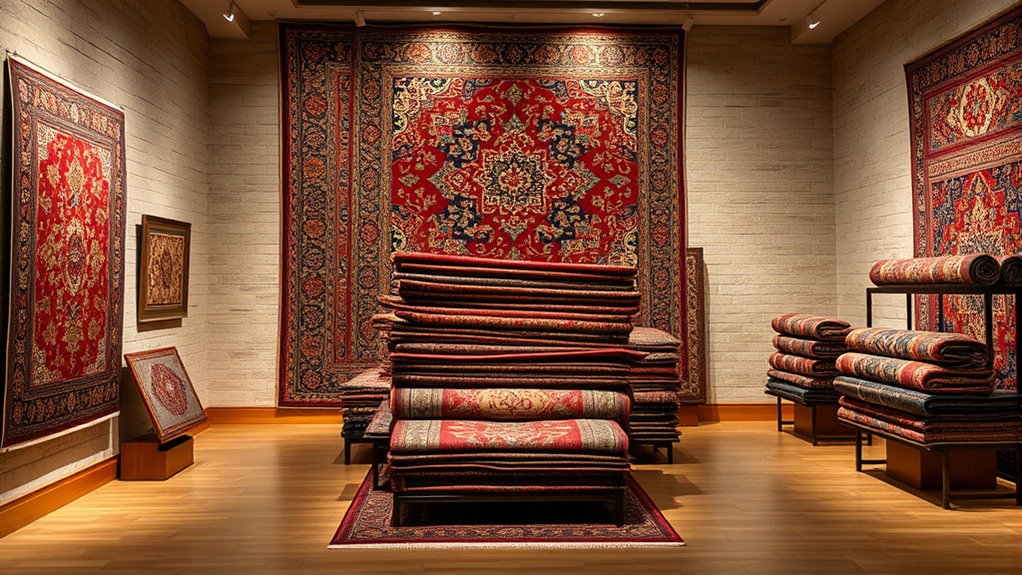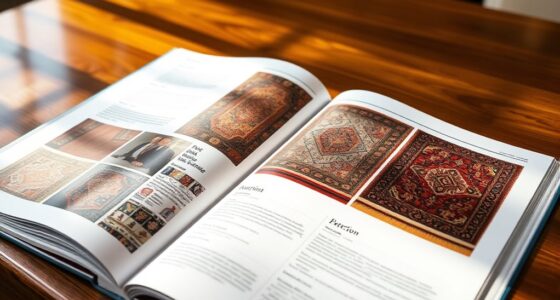To bequeath your rugs to museums, start by having them professionally appraised to determine their value and significance. Include clear details about each piece in your estate planning documents or wills, and work with an estate attorney to guarantee proper legal steps. Choose museums that align with the collection’s cultural importance and confirm their donation policies. For more insights on preserving your legacy through rug donations, continue exploring ways to make your bequest meaningful and well-organized.
Key Takeaways
- Include detailed descriptions and valuation of rugs in estate documents to ensure proper transfer and recognition.
- Collaborate with estate planning attorneys to create clear bequest instructions respecting cultural significance.
- Research and select museums aligned with the collection’s cultural and artistic focus before making a donation.
- Communicate with family and beneficiaries about the importance and future care of the rugs to prevent conflicts.
- Obtain necessary legal and tax documentation, including appraisal reports and donation agreements, to facilitate smooth transfer.
Assessing the Value and Significance of Your Rug Collection
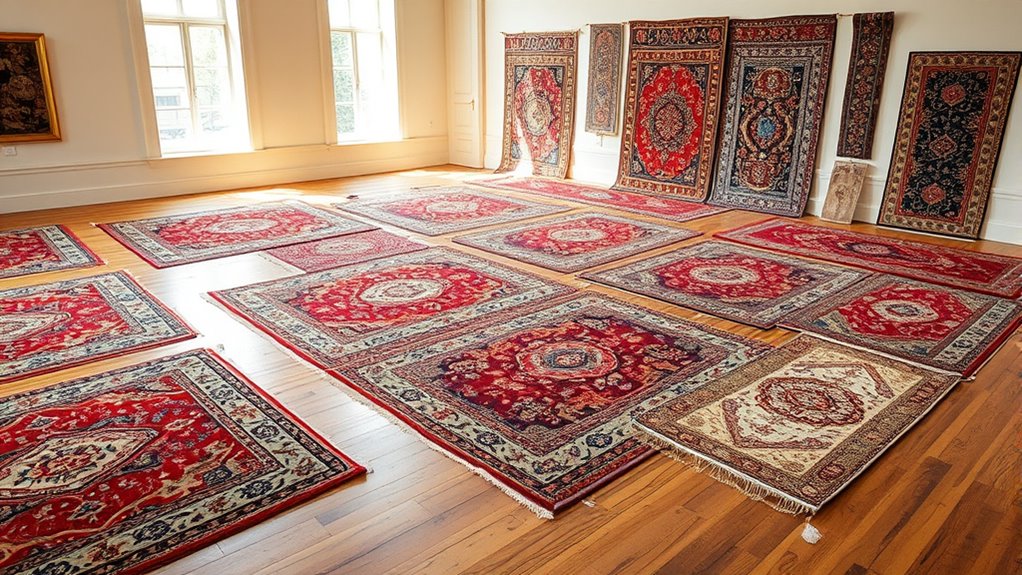
Understanding the true value and significance of your rug collection is essential for effective estate planning. To do this, you should arrange for a professional rug appraisal, which provides an accurate assessment of each piece’s worth. Beyond monetary value, consider the cultural significance of your rugs—they often reflect rich histories and traditions that add to their importance. Knowing both the financial and cultural aspects helps you make informed decisions about preservation and potential donations. Cataloging your collection’s details, including origin, age, and condition, also enhances its estate value. Additionally, understanding the cultural impact of your rugs can deepen your appreciation of their significance and influence how they are preserved or displayed. By understanding these elements, you ensure your collection’s true worth is recognized, whether you decide to pass it down to heirs or donate it to a museum.
Incorporating Rugs Into Your Estate Planning Documents
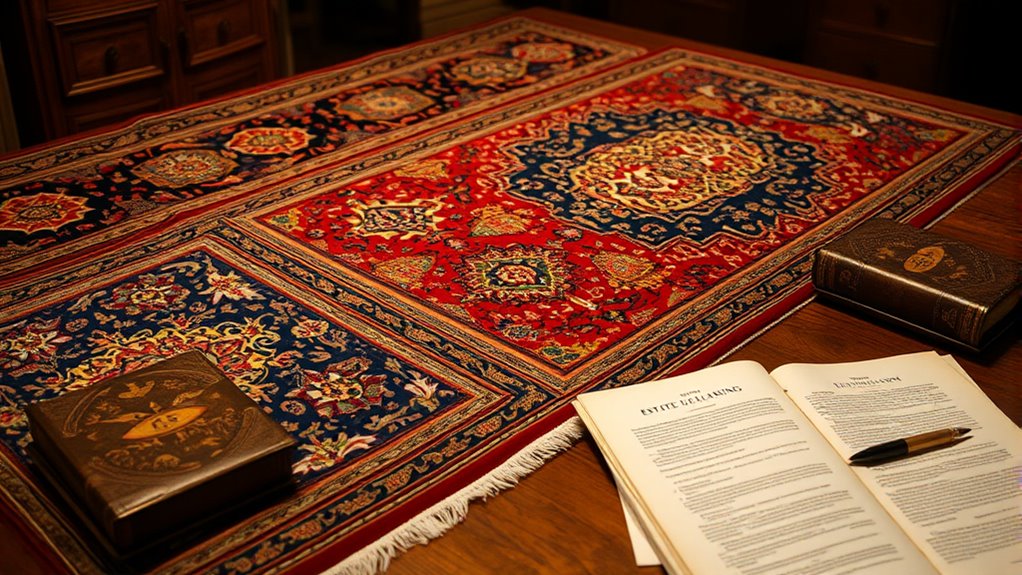
Including your rug collection in your estate planning documents guarantees that its value and significance are protected and properly transferred. Vintage textiles often carry deep cultural symbolism, reflecting traditions and artistry from different regions. To ensure these pieces are preserved, specify your wishes clearly in your will or trust. Detail whether you want certain rugs donated to museums or kept within your family. Consider appraising your collection to establish their worth, and include this information in your estate documents for clarity. Additionally, work with an estate planning attorney to incorporate specific bequest instructions for your vintage textiles, emphasizing their cultural importance. Properly incorporating your rugs into your estate plan helps honor their history and ensures they find a meaningful future beyond your lifetime. Understanding vetted products and consulting with experts can further safeguard your collection’s legacy.
Choosing the Right Museums for Your Bequest

When selecting museums for your rug bequest, it’s essential to contemplate institutions that align with your collection’s cultural significance and preservation standards. You want a museum that values the history and story behind your rugs, ensuring they’re appreciated and protected appropriately. Review each museum’s collection policies to confirm they accept textile or fiber arts donations and follow proper conservation practices. Consider whether the museum’s mission aligns with your intent to educate or showcase cultural heritage. Visiting potential recipients can help you gauge their commitment to preservation and public engagement. Ensuring the museum has a strong reputation for handling textile arts can provide additional confidence that your collection will be well cared for. Choosing the right museum ensures your bequest will honor your intentions, reach the right audience, and receive the care it deserves long after you’re gone.
Legal Considerations and Documentation for Gifted Rugs

Choosing the right museum guarantees your rugs are preserved and appreciated, but it’s equally important to address the legal aspects of your gift. Guarantee proper documentation protects your intentions and maintains the cultural heritage you wish to share. A clear donation agreement can also help facilitate asset donation procedures and ensure smooth transfer of ownership.
- Draft a clear, written donation agreement outlining your intent
- Verify the museum’s legal authority to accept donations
- Consider tax implications and obtain necessary tax receipts
- Address ethical considerations, respecting cultural significance
- Consult an estate planning attorney to ensure compliance with local laws
These steps help prevent disputes and safeguard your legacy. Proper legal considerations ensure your rugs’ donation aligns with your values and the museum’s mission, honoring both your wishes and the cultural importance of your family heirlooms.
Ensuring Proper Conservation and Care of Donated Rugs
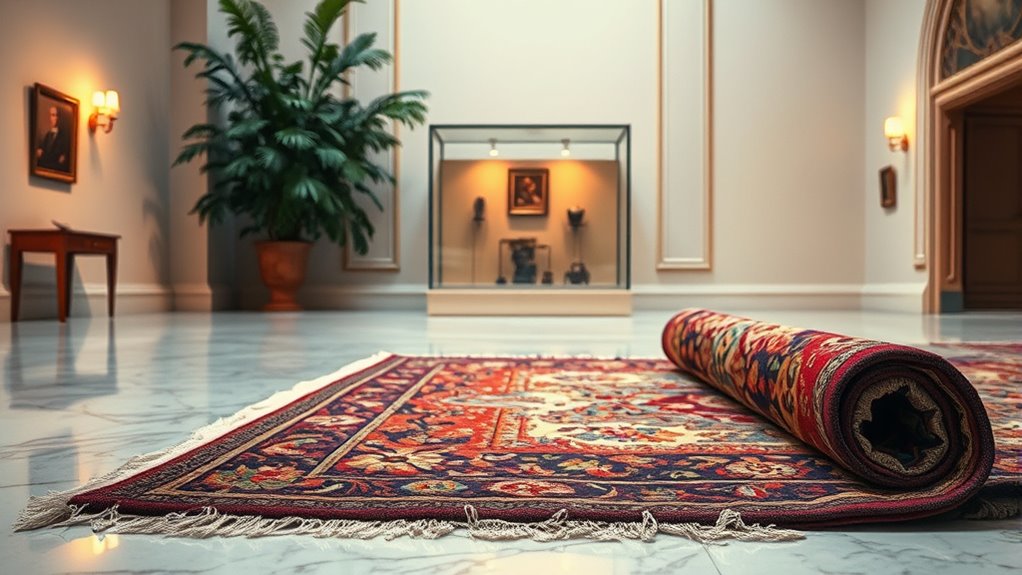
To guarantee your donated rugs remain in excellent condition, you need to apply proper preservation techniques and handling practices. Correct storage procedures also play a crucial role in protecting their quality over time. Additionally, maintaining an ongoing conservation routine helps preserve their value and beauty for future generations. Incorporating appropriate storage techniques ensures that the rugs are protected from environmental damage and deterioration.
Preservation Techniques and Methods
Proper preservation of donated rugs is essential to maintain their beauty and value over time. You should focus on techniques that protect fiber quality and preserve vibrant dyes. Conducting fiber analysis helps identify materials, guiding appropriate conservation methods. Ensuring dye preservation involves controlling light exposure and humidity levels to prevent fading. Consider these key techniques:
- Regular cleaning to remove dust and dirt
- Controlling temperature and humidity for stability
- Using appropriate padding during display or storage
- Avoiding direct sunlight to prevent dye fading
- Consulting conservators for specialized treatments
- Incorporating textile art techniques to enhance preservation and display methods
Handling and Storage Procedures
Handling and storage are critical to preserving the integrity of donated rugs. You should always follow proper cleaning protocols before storing or moving rugs to prevent dirt and pests from causing damage. When handling rugs, wear gloves to avoid oils and dirt transfer. Store rugs in a climate-controlled environment to prevent deterioration caused by humidity, temperature fluctuations, or light exposure. Use appropriate padding and supports to avoid creasing or crushing the fibers. Roll rugs with the pile facing inward and avoid folding them sharply. Regularly inspect stored rugs for signs of pests or moisture issues. Maintaining consistent climate control and adhering to cleaning protocols help guarantee the long-term conservation of your donated rugs, safeguarding their beauty and value for future generations. Additionally, implementing proper storage techniques can further enhance the longevity and preservation of valuable textiles.
Ongoing Conservation Responsibilities
Maintaining the condition of donated rugs requires ongoing attention and proactive care. To uphold restoration ethics and cultural authenticity, you must monitor and address wear, stains, and fading promptly. Regular cleaning by trained conservators prevents deterioration without compromising the rug’s integrity. Environmental controls, like stable humidity and temperature, are essential for preservation. You should also document any conservation work to ensure transparency and respect for the rug’s history. When necessary, perform gentle restoration that respects the original craftsmanship. Educate staff and visitors about proper handling to avoid damage. Consider the rug’s cultural significance during conservation efforts, ensuring authenticity remains intact. Incorporating preventive conservation strategies and maintaining a detailed preservation plan can further safeguard these textiles over time. By staying vigilant, you help preserve these textiles for future generations to appreciate and study.
Communicating Your Bequest to Family and Beneficiaries

Have you considered how best to share your estate plans with your family and beneficiaries? Open family discussions ensure everyone understands your intentions and reduces potential conflicts. Use storytelling techniques to make your explanations meaningful, sharing the history or significance behind each rug you plan to bequeath. This approach helps loved ones appreciate the value and importance of your choices, fostering respect and understanding. Clearly communicate your wishes, emphasizing why certain pieces matter to you and how you envision their future. By engaging your family in these conversations, you create a shared sense of purpose and preserve your legacy. Remember, transparency and emotional connection make your bequest more impactful and ensure your plans are honored with care. Incorporating insights from celebrity lifestyle insights can also inspire your own planning process, making it more engaging and memorable.
Frequently Asked Questions
How Do I Determine the Optimal Timing for Donating My Rugs?
When figuring out donation timing, you should consider your rugs’ condition and your financial goals. Align your donation with the museum’s donation schedule for maximum impact and potential tax benefits. You might also want to time your gift to coincide with a tax year-end or a significant personal milestone. Ultimately, planning ahead guarantees your donation supports the museum and benefits you financially.
What Are Potential Tax Benefits of Bequeathing Rugs to Museums?
Think of bequeathing rugs as planting seeds for future benefits. When you donate to a museum, you often get a tax deduction, which can lower your taxable income like a shield. This act also helps with estate reduction, potentially decreasing estate taxes owed. By doing this, you’re not only supporting culture but also making your estate more efficient, ensuring your legacy benefits both the museum and your heirs.
Can I Specify Which Museum Departments Should Receive My Rugs?
You can specify which museum departments should receive your rugs through a museum donation, ensuring your rug allocation aligns with your wishes. When making your gift, discuss your preferences with the museum’s development or curatorial staff. This way, you can designate specific departments or collections for your rugs, giving you control over their final placement and ensuring your donation supports areas most meaningful to you.
How Can I Ensure My Rugs’ Cultural Significance Is Preserved?
To guarantee your rugs’ cultural significance is preserved, you should focus on implementing preservation techniques and cultural documentation. You can work with experts to choose proper storage, display methods, and conservation practices that protect their integrity. Additionally, provide detailed records and histories to museums, highlighting their cultural importance. By actively documenting and caring for your rugs, you help future generations appreciate their heritage and maintain their cultural value.
Are There Restrictions on the Types of Rugs Museums Accept?
You should know that museums have specific acceptance policies, which may limit the types of rugs they accept. They often require rugs to meet certain condition standards, ensuring preservation and display quality. Some museums prefer rugs from particular regions or periods, and they might restrict highly fragile or damaged pieces. To verify your rugs are accepted, contact museums ahead of time to understand their specific acceptance policies and rug condition requirements.
Conclusion
By carefully evaluating your collection, thoughtfully incorporating your wishes into estate plans, selecting meaningful museums, and ensuring proper legal and conservation measures, you create a lasting legacy. Communicate clearly with family and beneficiaries, so your intentions are understood. Ultimately, you preserve history, share beauty, and inspire future generations—maintaining your passion, honoring your collection, and enriching cultural heritage for years to come. Your bequest becomes a timeless gift, a lasting testimony, and an enduring contribution.
